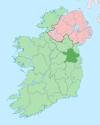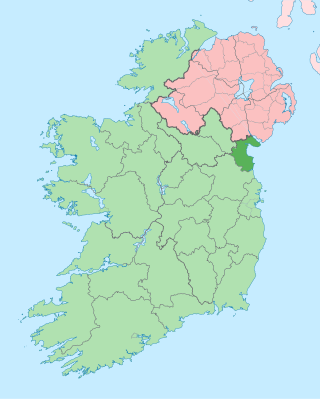
County Louth is a coastal county in the Eastern and Midland Region of Ireland, within the province of Leinster. Louth is bordered by the counties of Meath to the south, Monaghan to the west, Armagh to the north and Down to the north-east, across Carlingford Lough. It is the smallest county in Ireland by land area and the 17th most populous, with just over 139,100 residents as of 2022. The county is named after the village of Louth. Louth County Council is the local authority for the county.

County Cavan is a county in Ireland. It is in the province of Ulster and is part of the Northern and Western Region. It is named after the town of Cavan and is based on the historic Gaelic territory of East Breffny (Bréifne). Cavan County Council is the local authority for the county, which had a population of 81,704 at the 2022 census.

Drumcondra is a residential area and inner suburb on the Northside of Dublin, Ireland. It is administered by Dublin City Council. The River Tolka and the Royal Canal flow through the area.

Ardee is a town and townland in County Louth, Ireland. It is located at the intersection of the N2, N52, and N33 roads. The town shows evidence of development from the thirteenth century onward but as a result of the continued development of the town since then much of the fabric of the medieval town has been removed. The town is in a civil parish of the same name.

Drumshanbo is a small town situated in the heart of County Leitrim, Ireland. Drumshanbo is surrounded by a scenic area of soft rolling hills, woodlands, lakes and the Sliabh an Iarainn and Arigna mountains. It is a well preserved town with traditional pubs, shops, and restaurants.

Shercock ; Irish: Searcóg) is a small town and civil parish in the east of County Cavan, Ireland. As of the 2022 census, the population of the town was 574.

Nobber is a village in north County Meath, Ireland. It is on the Navan–Kingscourt road (R162), about 19 kilometres (12 mi) north of Navan. This places the village about 60 kilometres (37 mi) from the M50 motorway, the orbital motorway of Dublin. The village is in a townland and civil parish of the same name.
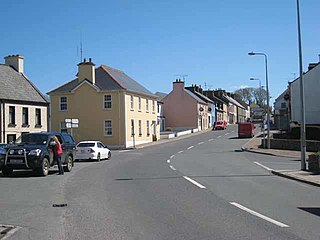
Drumkeeran, also Drumkeerin, is a village and townland in County Leitrim, Ireland, located at the junction of the R280 and R200 roads. It is situated in drumlin hills at the foot of Corry Mountain, just north of Lough Allen.
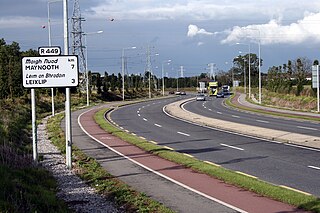
A regional road in the Republic of Ireland is a class of road not forming a major route, but nevertheless forming a link in the national route network. There are over 11,600 kilometres of regional roads. Regional roads are numbered with three-digit route numbers, prefixed by "R". The equivalent road category in Northern Ireland are B roads.

Tullyallen is a village, civil parish and townland 6 km north-west of the town of Drogheda in County Louth, Ireland. It is in the historic Barony of Ferrard. It is located in the historical Boyne Valley, in the Catholic parish of Mellifont ; it is also close to Newgrange, Knowth and Dowth burial mounds, Monasterboice monastery, and to the Battle of the Boyne site.
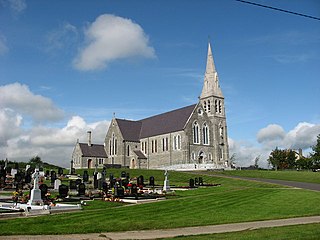
Louth is a village at the heart of County Louth, Ireland. It is roughly 11 km south-west of the town of Dundalk, 10.9 km to neighbouring town Ardee. The village is approximately 15 km south-east of Carrickmacross town in County Monaghan. The village gave its name to the county. The village is in a barony and civil parish of the same name.

Kingscourt, historically known as Dunaree, is a town in County Cavan, Ireland. It is located near the Cavan–Meath border. The town was founded near the site of the old village of Cabra, by Mervyn Pratt, towards the end of the 18th century, and was completed by his brother, the Reverend Joseph Pratt. As of the 2022 census, the population was 2,955.

Achaidh Leithdeircc is an ancient location in Ireland reputed to be the site of a historic battle, or series of battles, around the year 331 AD, in which the forces of the Three Collas along with men of Connaught eventually conquered vast tracts of territory from the tribes of the Ulaid. The prehistoric royal site of Navan Fort was burnt and plundered and ultimately this territory would re-emerge as part of the kingdom or federation of Airgíalla.
Magheracloone is a parish in south County Monaghan. Its name comes from the Irish Machaire Cluana which means 'plain of meadow'. A generally hilly parish; its name is derived from its most important place in ancient times; a flat area of land in the townland of Camaghy, on which the sports ground and ancient church of St. Molua were located. The parish covers 12,952 statute acres in area, making it the largest parish in South Monaghan. The parish borders three neighbouring counties; Cavan, Louth and Meath. Magheracloone is the only parish in Monaghan to border Meath; it is located approximately 90 km from both Belfast and Dublin.
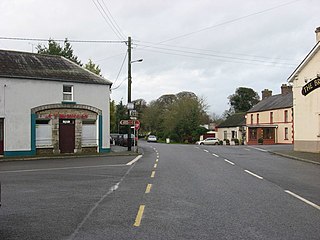
Mountnugent, or Mount Nugent, historically known as Dalysbridge, is a village and townland in southern County Cavan, Ireland. The village is on the R154 regional road, at a river crossing near Lough Sheelin.

The River Dee is a river in eastern Ireland, flowing from County Cavan to flow into the River Glyde near the coast, in County Louth.

The Burning of Wildgoose Lodge was an arson and murder attack on Wildgoose Lodge, County Louth, Ireland, on the night of 29–30 October 1816, in which eight occupants were killed, including an infant aged five months. The house was near the County Monaghan border, in the townland of Reaghstown, civil parish of Philipstown, barony of Ardee. Eighteen men were executed for the crime, many of them innocent. The event inspired an 1830 short story by William Carleton (1794–1869) and the circumstances have been the subject of historical and political debate.

Kilmainhamwood, historically simply Killmainham, is a village and townland in north County Meath, Ireland. The village is built on the River Dee and is situated north of Whitewood Lake. The village is located on local roads. Neighbouring parishes are Kingscourt to the north, Drumconrath to the east, Nobber to the south-east, Moynalty to the south and Bailieborough to the west.
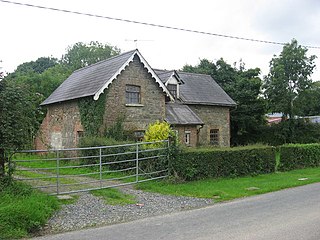
Drumcar is a village and a historical parish, in the barony of Ardee in County Louth, Ireland.

Drum is a village and townland in the west of County Monaghan in the Republic of Ireland. It is one of the only Protestant-majority settlements in the Republic of Ireland.






















